Potential Use of Augmented Reality in Tourism, Hospitality, Events
VerifiedAdded on 2022/07/28
|14
|2898
|12
Report
AI Summary
This report delves into the transformative potential of Augmented Reality (AR) technology within the tourism, hospitality, and events (THE) industries. It begins by defining AR and tracing its evolution, highlighting key facts and figures that illustrate its growing market size and adoption rates, including the increasing use of smartphones and smart glasses. The report then provides a comprehensive overview of AR's development, from its inception in the 1960s to its current applications, showcasing examples of its use across various sectors like entertainment, manufacturing, and security. The core of the report focuses on the practical applications of AR within the THE industries, offering examples such as interactive hotel room tours, augmented hotel entertainment, and beacon technology. It discusses the benefits of AR, including enhanced customer experiences, increased accessibility, and improved brand perception. The report concludes by emphasizing the importance of AR in THE and other sectors, though it acknowledges the absence of discussion of its limitations. This report is a comprehensive examination of AR's present and future role in revolutionizing customer experiences and driving innovation within the THE industries.
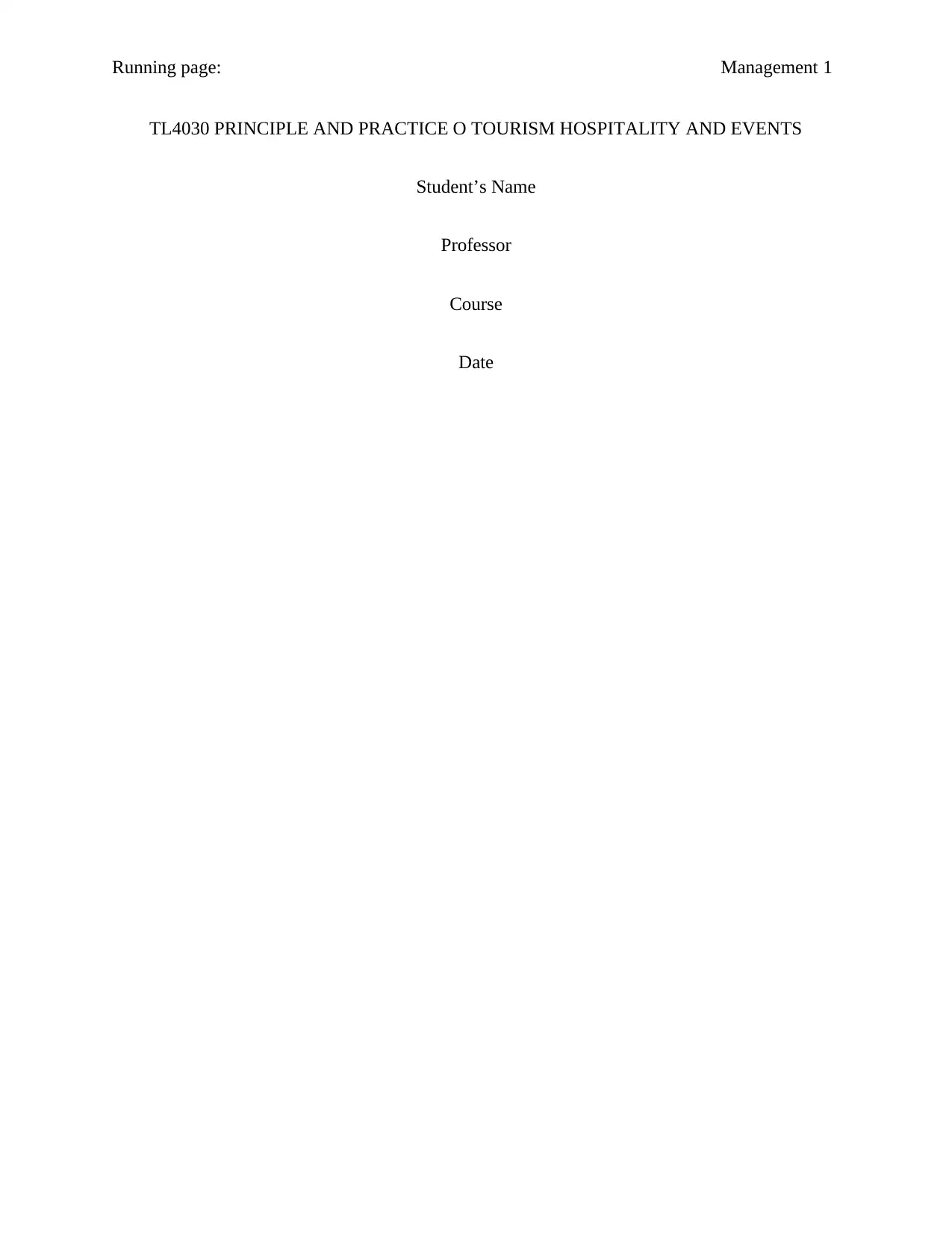
Running page: Management 1
TL4030 PRINCIPLE AND PRACTICE O TOURISM HOSPITALITY AND EVENTS
Student’s Name
Professor
Course
Date
TL4030 PRINCIPLE AND PRACTICE O TOURISM HOSPITALITY AND EVENTS
Student’s Name
Professor
Course
Date
Paraphrase This Document
Need a fresh take? Get an instant paraphrase of this document with our AI Paraphraser
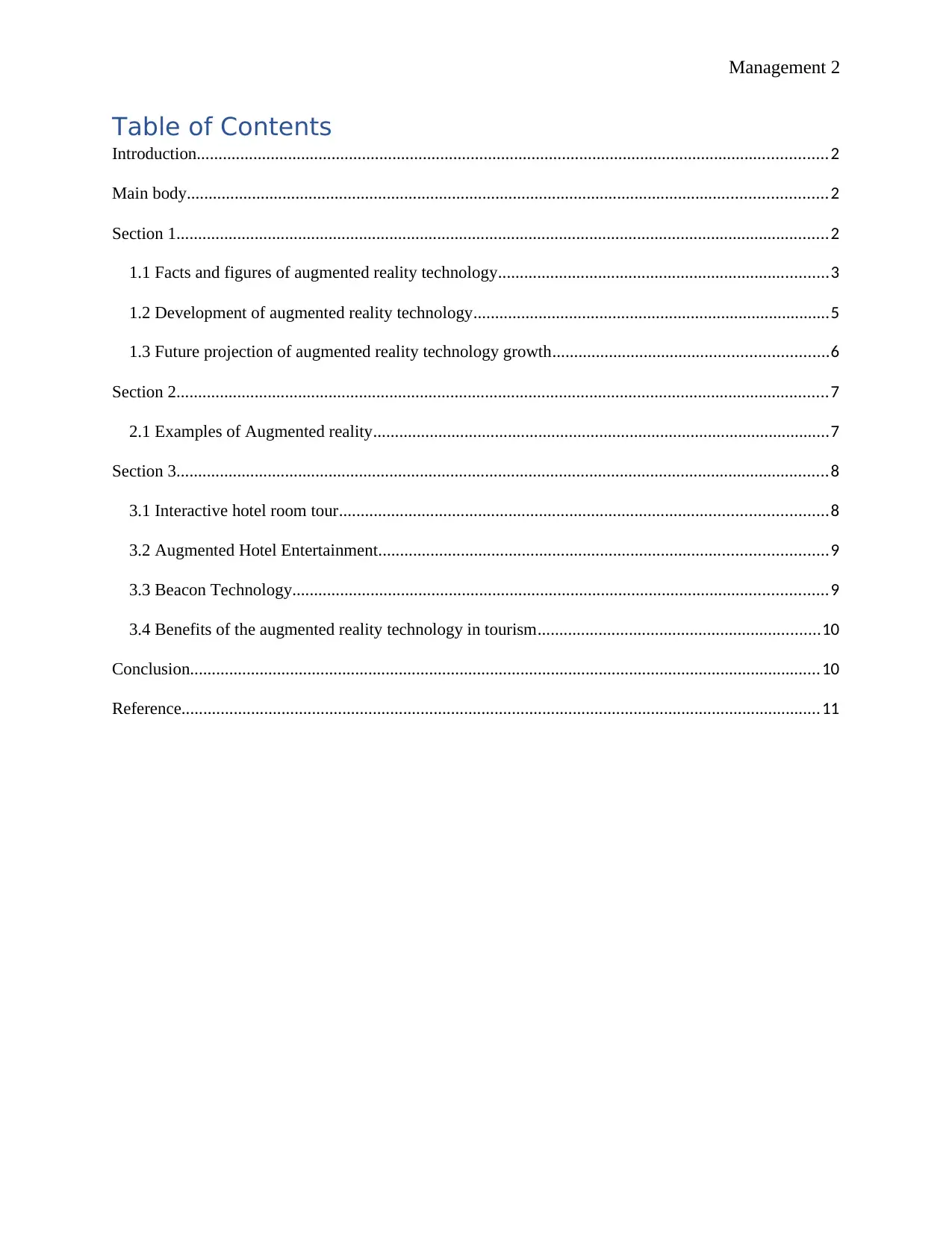
Management 2
Table of Contents
Introduction.................................................................................................................................................2
Main body...................................................................................................................................................2
Section 1......................................................................................................................................................2
1.1 Facts and figures of augmented reality technology............................................................................3
1.2 Development of augmented reality technology..................................................................................5
1.3 Future projection of augmented reality technology growth...............................................................6
Section 2......................................................................................................................................................7
2.1 Examples of Augmented reality.........................................................................................................7
Section 3......................................................................................................................................................8
3.1 Interactive hotel room tour................................................................................................................8
3.2 Augmented Hotel Entertainment.......................................................................................................9
3.3 Beacon Technology...........................................................................................................................9
3.4 Benefits of the augmented reality technology in tourism.................................................................10
Conclusion.................................................................................................................................................10
Reference...................................................................................................................................................11
Table of Contents
Introduction.................................................................................................................................................2
Main body...................................................................................................................................................2
Section 1......................................................................................................................................................2
1.1 Facts and figures of augmented reality technology............................................................................3
1.2 Development of augmented reality technology..................................................................................5
1.3 Future projection of augmented reality technology growth...............................................................6
Section 2......................................................................................................................................................7
2.1 Examples of Augmented reality.........................................................................................................7
Section 3......................................................................................................................................................8
3.1 Interactive hotel room tour................................................................................................................8
3.2 Augmented Hotel Entertainment.......................................................................................................9
3.3 Beacon Technology...........................................................................................................................9
3.4 Benefits of the augmented reality technology in tourism.................................................................10
Conclusion.................................................................................................................................................10
Reference...................................................................................................................................................11
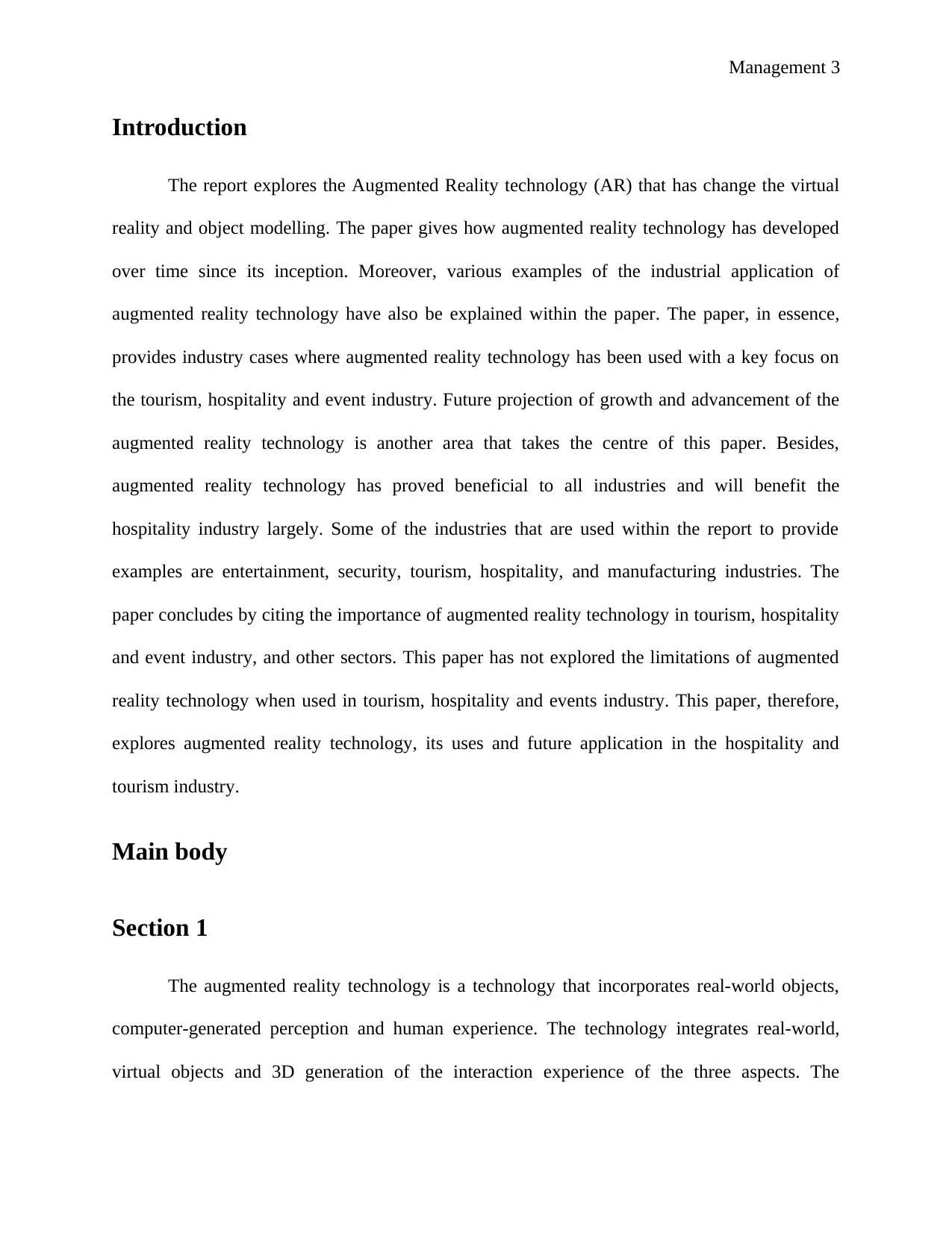
Management 3
Introduction
The report explores the Augmented Reality technology (AR) that has change the virtual
reality and object modelling. The paper gives how augmented reality technology has developed
over time since its inception. Moreover, various examples of the industrial application of
augmented reality technology have also be explained within the paper. The paper, in essence,
provides industry cases where augmented reality technology has been used with a key focus on
the tourism, hospitality and event industry. Future projection of growth and advancement of the
augmented reality technology is another area that takes the centre of this paper. Besides,
augmented reality technology has proved beneficial to all industries and will benefit the
hospitality industry largely. Some of the industries that are used within the report to provide
examples are entertainment, security, tourism, hospitality, and manufacturing industries. The
paper concludes by citing the importance of augmented reality technology in tourism, hospitality
and event industry, and other sectors. This paper has not explored the limitations of augmented
reality technology when used in tourism, hospitality and events industry. This paper, therefore,
explores augmented reality technology, its uses and future application in the hospitality and
tourism industry.
Main body
Section 1
The augmented reality technology is a technology that incorporates real-world objects,
computer-generated perception and human experience. The technology integrates real-world,
virtual objects and 3D generation of the interaction experience of the three aspects. The
Introduction
The report explores the Augmented Reality technology (AR) that has change the virtual
reality and object modelling. The paper gives how augmented reality technology has developed
over time since its inception. Moreover, various examples of the industrial application of
augmented reality technology have also be explained within the paper. The paper, in essence,
provides industry cases where augmented reality technology has been used with a key focus on
the tourism, hospitality and event industry. Future projection of growth and advancement of the
augmented reality technology is another area that takes the centre of this paper. Besides,
augmented reality technology has proved beneficial to all industries and will benefit the
hospitality industry largely. Some of the industries that are used within the report to provide
examples are entertainment, security, tourism, hospitality, and manufacturing industries. The
paper concludes by citing the importance of augmented reality technology in tourism, hospitality
and event industry, and other sectors. This paper has not explored the limitations of augmented
reality technology when used in tourism, hospitality and events industry. This paper, therefore,
explores augmented reality technology, its uses and future application in the hospitality and
tourism industry.
Main body
Section 1
The augmented reality technology is a technology that incorporates real-world objects,
computer-generated perception and human experience. The technology integrates real-world,
virtual objects and 3D generation of the interaction experience of the three aspects. The
⊘ This is a preview!⊘
Do you want full access?
Subscribe today to unlock all pages.

Trusted by 1+ million students worldwide
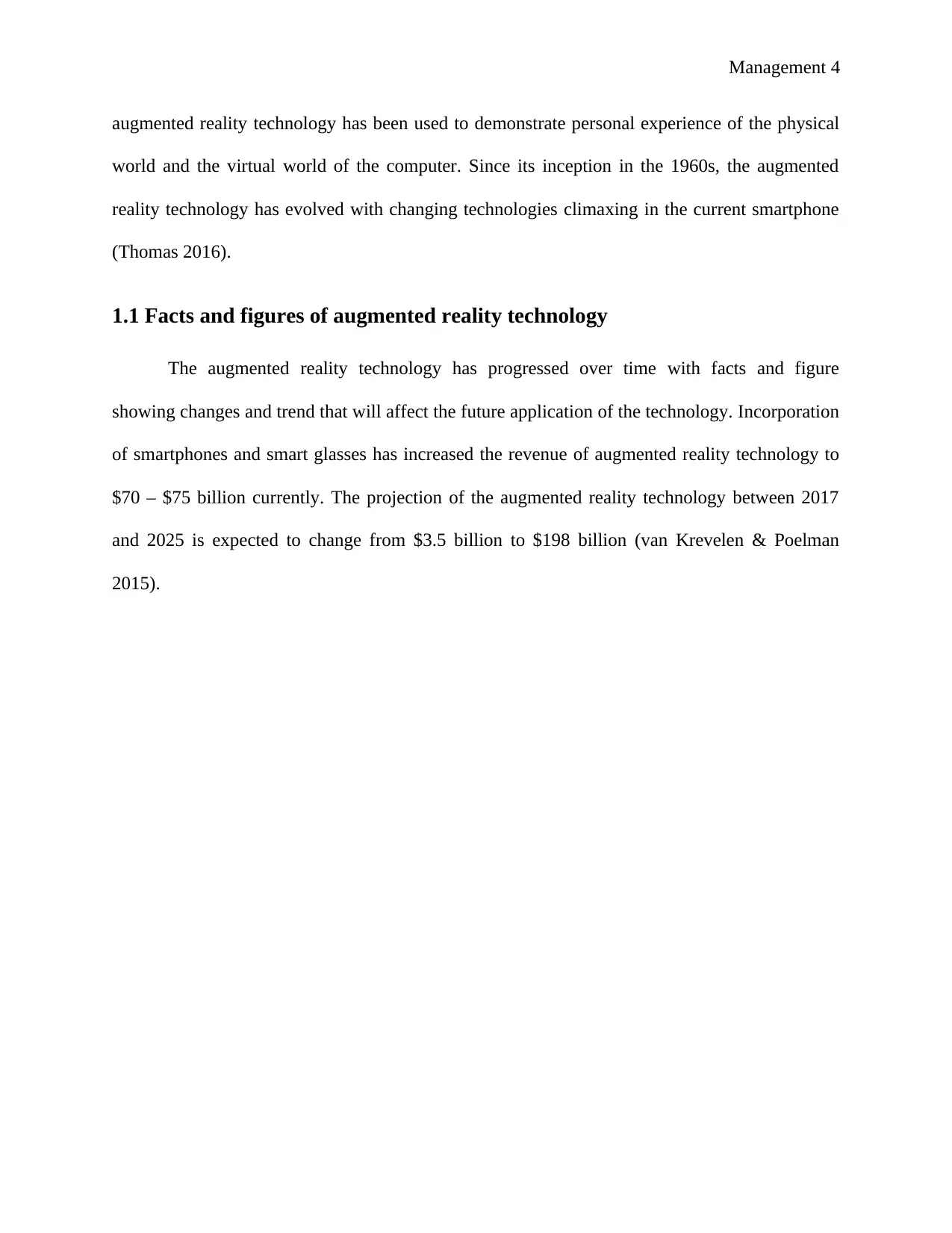
Management 4
augmented reality technology has been used to demonstrate personal experience of the physical
world and the virtual world of the computer. Since its inception in the 1960s, the augmented
reality technology has evolved with changing technologies climaxing in the current smartphone
(Thomas 2016).
1.1 Facts and figures of augmented reality technology
The augmented reality technology has progressed over time with facts and figure
showing changes and trend that will affect the future application of the technology. Incorporation
of smartphones and smart glasses has increased the revenue of augmented reality technology to
$70 – $75 billion currently. The projection of the augmented reality technology between 2017
and 2025 is expected to change from $3.5 billion to $198 billion (van Krevelen & Poelman
2015).
augmented reality technology has been used to demonstrate personal experience of the physical
world and the virtual world of the computer. Since its inception in the 1960s, the augmented
reality technology has evolved with changing technologies climaxing in the current smartphone
(Thomas 2016).
1.1 Facts and figures of augmented reality technology
The augmented reality technology has progressed over time with facts and figure
showing changes and trend that will affect the future application of the technology. Incorporation
of smartphones and smart glasses has increased the revenue of augmented reality technology to
$70 – $75 billion currently. The projection of the augmented reality technology between 2017
and 2025 is expected to change from $3.5 billion to $198 billion (van Krevelen & Poelman
2015).
Paraphrase This Document
Need a fresh take? Get an instant paraphrase of this document with our AI Paraphraser
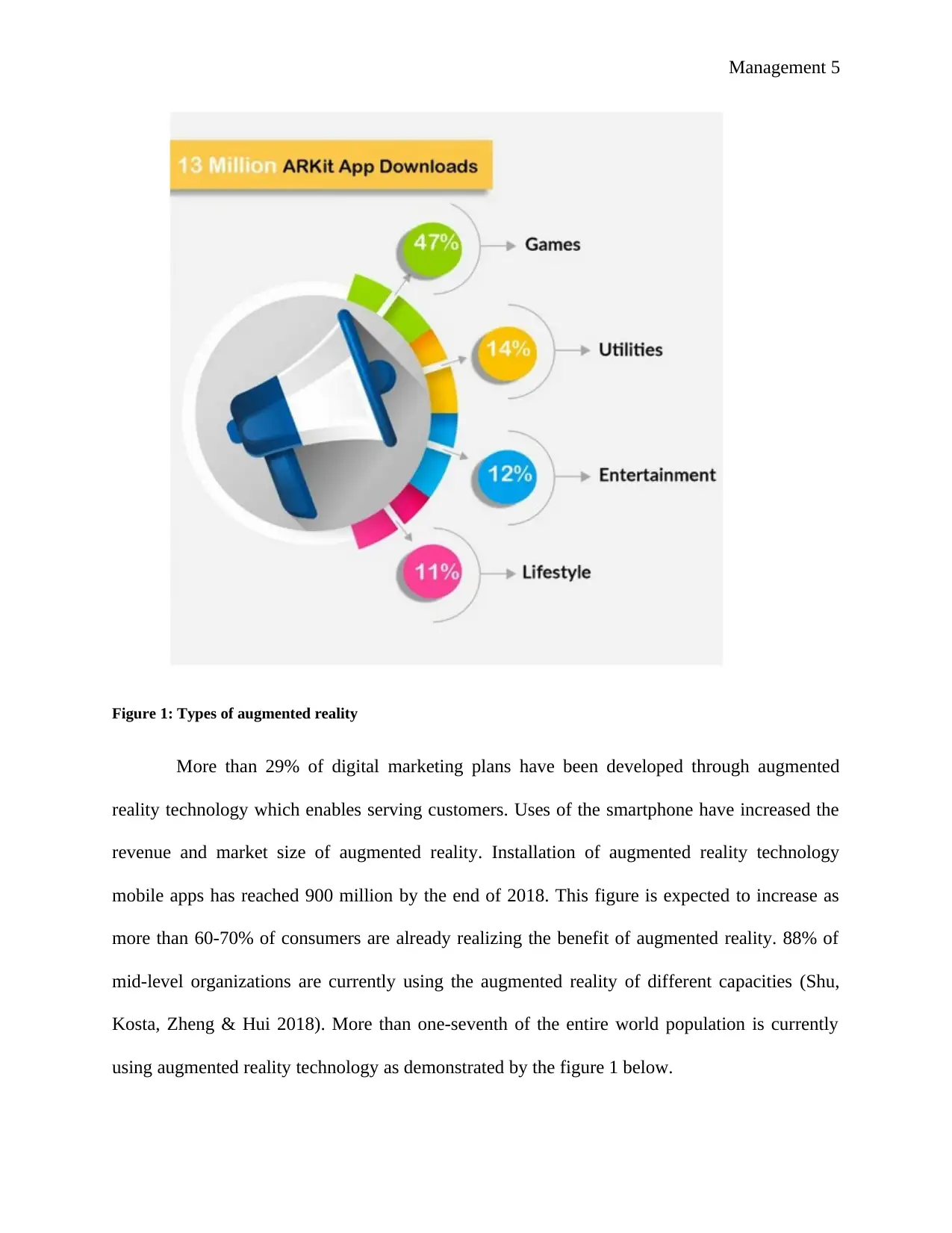
Management 5
Figure 1: Types of augmented reality
More than 29% of digital marketing plans have been developed through augmented
reality technology which enables serving customers. Uses of the smartphone have increased the
revenue and market size of augmented reality. Installation of augmented reality technology
mobile apps has reached 900 million by the end of 2018. This figure is expected to increase as
more than 60-70% of consumers are already realizing the benefit of augmented reality. 88% of
mid-level organizations are currently using the augmented reality of different capacities (Shu,
Kosta, Zheng & Hui 2018). More than one-seventh of the entire world population is currently
using augmented reality technology as demonstrated by the figure 1 below.
Figure 1: Types of augmented reality
More than 29% of digital marketing plans have been developed through augmented
reality technology which enables serving customers. Uses of the smartphone have increased the
revenue and market size of augmented reality. Installation of augmented reality technology
mobile apps has reached 900 million by the end of 2018. This figure is expected to increase as
more than 60-70% of consumers are already realizing the benefit of augmented reality. 88% of
mid-level organizations are currently using the augmented reality of different capacities (Shu,
Kosta, Zheng & Hui 2018). More than one-seventh of the entire world population is currently
using augmented reality technology as demonstrated by the figure 1 below.
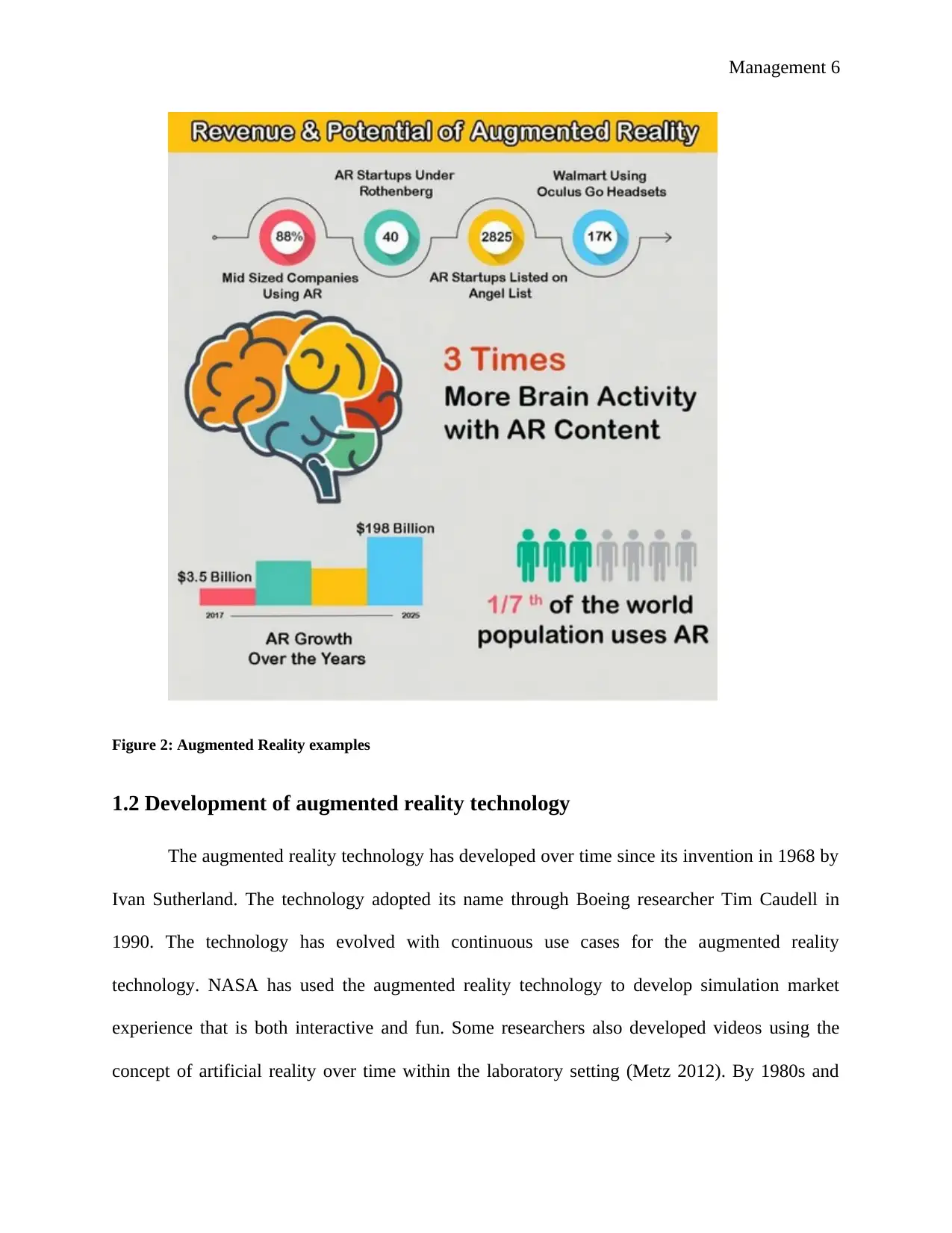
Management 6
Figure 2: Augmented Reality examples
1.2 Development of augmented reality technology
The augmented reality technology has developed over time since its invention in 1968 by
Ivan Sutherland. The technology adopted its name through Boeing researcher Tim Caudell in
1990. The technology has evolved with continuous use cases for the augmented reality
technology. NASA has used the augmented reality technology to develop simulation market
experience that is both interactive and fun. Some researchers also developed videos using the
concept of artificial reality over time within the laboratory setting (Metz 2012). By 1980s and
Figure 2: Augmented Reality examples
1.2 Development of augmented reality technology
The augmented reality technology has developed over time since its invention in 1968 by
Ivan Sutherland. The technology adopted its name through Boeing researcher Tim Caudell in
1990. The technology has evolved with continuous use cases for the augmented reality
technology. NASA has used the augmented reality technology to develop simulation market
experience that is both interactive and fun. Some researchers also developed videos using the
concept of artificial reality over time within the laboratory setting (Metz 2012). By 1980s and
⊘ This is a preview!⊘
Do you want full access?
Subscribe today to unlock all pages.

Trusted by 1+ million students worldwide
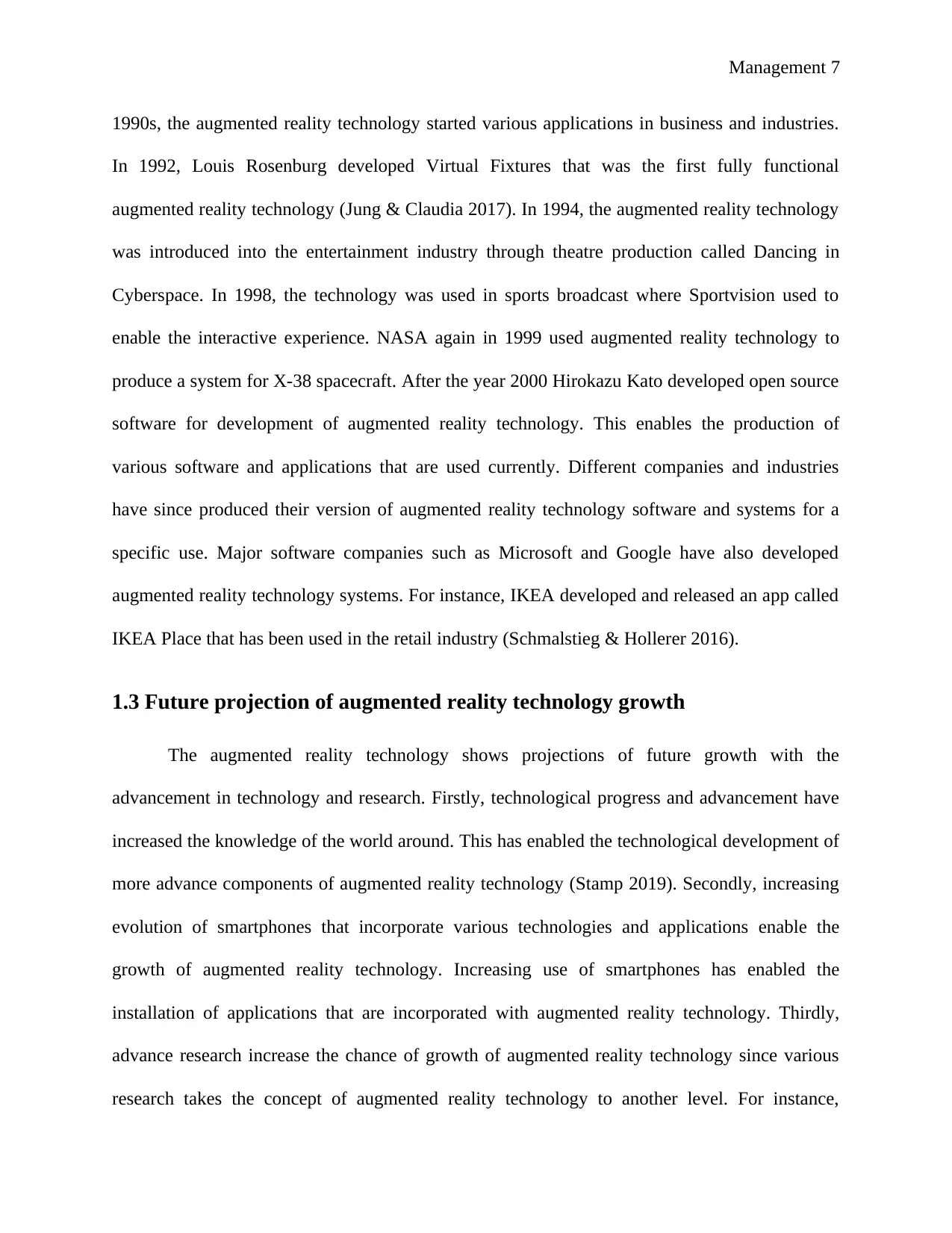
Management 7
1990s, the augmented reality technology started various applications in business and industries.
In 1992, Louis Rosenburg developed Virtual Fixtures that was the first fully functional
augmented reality technology (Jung & Claudia 2017). In 1994, the augmented reality technology
was introduced into the entertainment industry through theatre production called Dancing in
Cyberspace. In 1998, the technology was used in sports broadcast where Sportvision used to
enable the interactive experience. NASA again in 1999 used augmented reality technology to
produce a system for X-38 spacecraft. After the year 2000 Hirokazu Kato developed open source
software for development of augmented reality technology. This enables the production of
various software and applications that are used currently. Different companies and industries
have since produced their version of augmented reality technology software and systems for a
specific use. Major software companies such as Microsoft and Google have also developed
augmented reality technology systems. For instance, IKEA developed and released an app called
IKEA Place that has been used in the retail industry (Schmalstieg & Hollerer 2016).
1.3 Future projection of augmented reality technology growth
The augmented reality technology shows projections of future growth with the
advancement in technology and research. Firstly, technological progress and advancement have
increased the knowledge of the world around. This has enabled the technological development of
more advance components of augmented reality technology (Stamp 2019). Secondly, increasing
evolution of smartphones that incorporate various technologies and applications enable the
growth of augmented reality technology. Increasing use of smartphones has enabled the
installation of applications that are incorporated with augmented reality technology. Thirdly,
advance research increase the chance of growth of augmented reality technology since various
research takes the concept of augmented reality technology to another level. For instance,
1990s, the augmented reality technology started various applications in business and industries.
In 1992, Louis Rosenburg developed Virtual Fixtures that was the first fully functional
augmented reality technology (Jung & Claudia 2017). In 1994, the augmented reality technology
was introduced into the entertainment industry through theatre production called Dancing in
Cyberspace. In 1998, the technology was used in sports broadcast where Sportvision used to
enable the interactive experience. NASA again in 1999 used augmented reality technology to
produce a system for X-38 spacecraft. After the year 2000 Hirokazu Kato developed open source
software for development of augmented reality technology. This enables the production of
various software and applications that are used currently. Different companies and industries
have since produced their version of augmented reality technology software and systems for a
specific use. Major software companies such as Microsoft and Google have also developed
augmented reality technology systems. For instance, IKEA developed and released an app called
IKEA Place that has been used in the retail industry (Schmalstieg & Hollerer 2016).
1.3 Future projection of augmented reality technology growth
The augmented reality technology shows projections of future growth with the
advancement in technology and research. Firstly, technological progress and advancement have
increased the knowledge of the world around. This has enabled the technological development of
more advance components of augmented reality technology (Stamp 2019). Secondly, increasing
evolution of smartphones that incorporate various technologies and applications enable the
growth of augmented reality technology. Increasing use of smartphones has enabled the
installation of applications that are incorporated with augmented reality technology. Thirdly,
advance research increase the chance of growth of augmented reality technology since various
research takes the concept of augmented reality technology to another level. For instance,
Paraphrase This Document
Need a fresh take? Get an instant paraphrase of this document with our AI Paraphraser
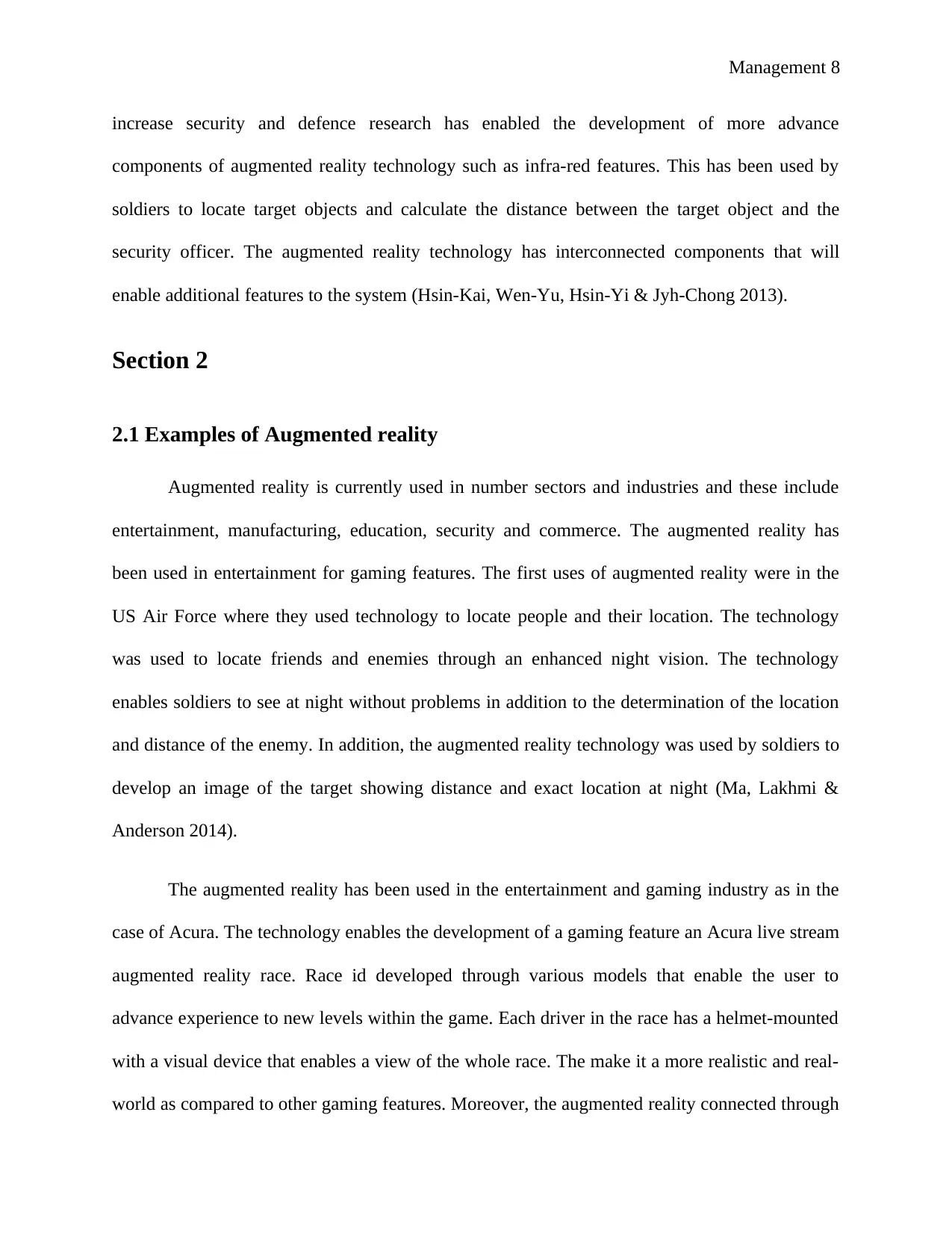
Management 8
increase security and defence research has enabled the development of more advance
components of augmented reality technology such as infra-red features. This has been used by
soldiers to locate target objects and calculate the distance between the target object and the
security officer. The augmented reality technology has interconnected components that will
enable additional features to the system (Hsin-Kai, Wen-Yu, Hsin-Yi & Jyh-Chong 2013).
Section 2
2.1 Examples of Augmented reality
Augmented reality is currently used in number sectors and industries and these include
entertainment, manufacturing, education, security and commerce. The augmented reality has
been used in entertainment for gaming features. The first uses of augmented reality were in the
US Air Force where they used technology to locate people and their location. The technology
was used to locate friends and enemies through an enhanced night vision. The technology
enables soldiers to see at night without problems in addition to the determination of the location
and distance of the enemy. In addition, the augmented reality technology was used by soldiers to
develop an image of the target showing distance and exact location at night (Ma, Lakhmi &
Anderson 2014).
The augmented reality has been used in the entertainment and gaming industry as in the
case of Acura. The technology enables the development of a gaming feature an Acura live stream
augmented reality race. Race id developed through various models that enable the user to
advance experience to new levels within the game. Each driver in the race has a helmet-mounted
with a visual device that enables a view of the whole race. The make it a more realistic and real-
world as compared to other gaming features. Moreover, the augmented reality connected through
increase security and defence research has enabled the development of more advance
components of augmented reality technology such as infra-red features. This has been used by
soldiers to locate target objects and calculate the distance between the target object and the
security officer. The augmented reality technology has interconnected components that will
enable additional features to the system (Hsin-Kai, Wen-Yu, Hsin-Yi & Jyh-Chong 2013).
Section 2
2.1 Examples of Augmented reality
Augmented reality is currently used in number sectors and industries and these include
entertainment, manufacturing, education, security and commerce. The augmented reality has
been used in entertainment for gaming features. The first uses of augmented reality were in the
US Air Force where they used technology to locate people and their location. The technology
was used to locate friends and enemies through an enhanced night vision. The technology
enables soldiers to see at night without problems in addition to the determination of the location
and distance of the enemy. In addition, the augmented reality technology was used by soldiers to
develop an image of the target showing distance and exact location at night (Ma, Lakhmi &
Anderson 2014).
The augmented reality has been used in the entertainment and gaming industry as in the
case of Acura. The technology enables the development of a gaming feature an Acura live stream
augmented reality race. Race id developed through various models that enable the user to
advance experience to new levels within the game. Each driver in the race has a helmet-mounted
with a visual device that enables a view of the whole race. The make it a more realistic and real-
world as compared to other gaming features. Moreover, the augmented reality connected through
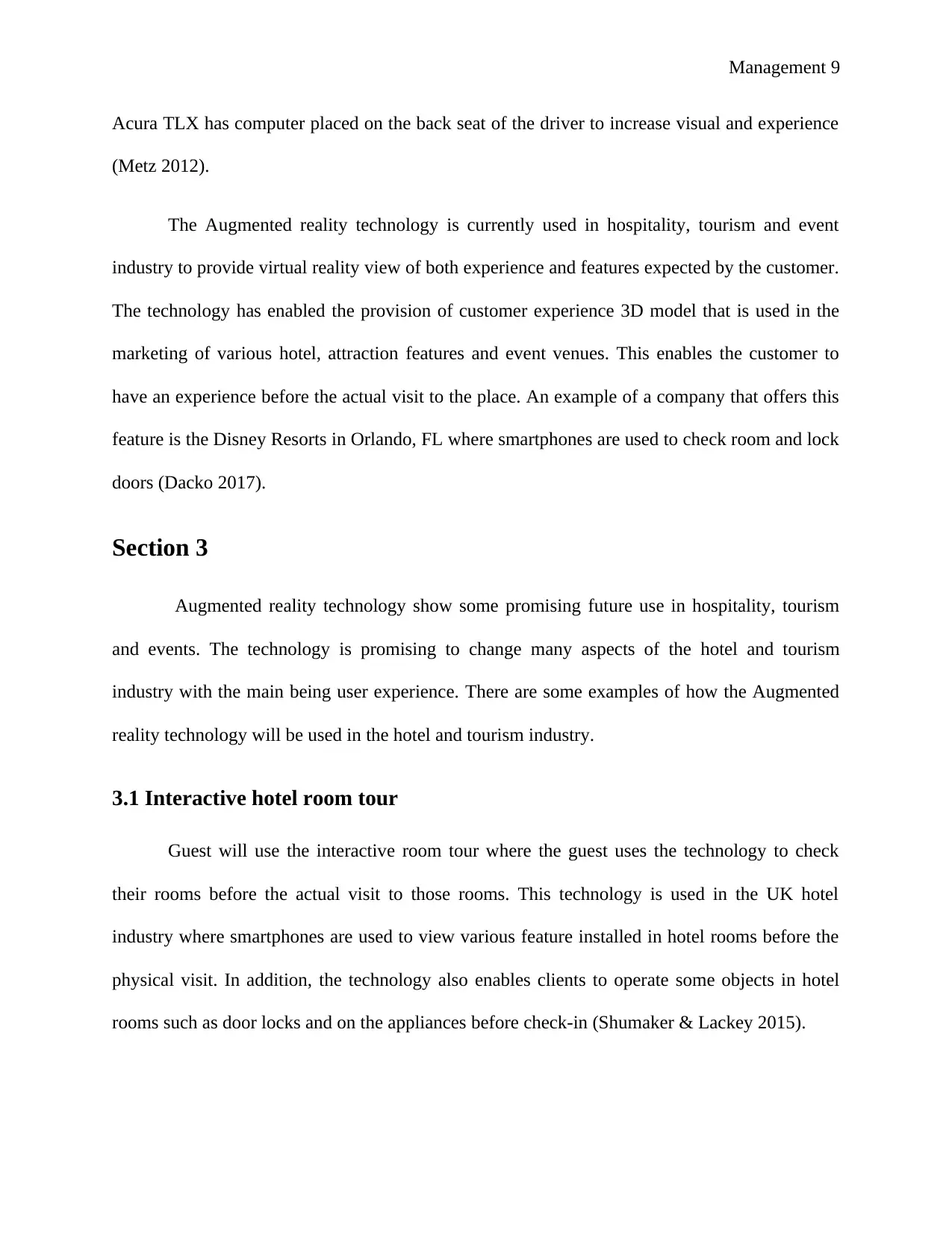
Management 9
Acura TLX has computer placed on the back seat of the driver to increase visual and experience
(Metz 2012).
The Augmented reality technology is currently used in hospitality, tourism and event
industry to provide virtual reality view of both experience and features expected by the customer.
The technology has enabled the provision of customer experience 3D model that is used in the
marketing of various hotel, attraction features and event venues. This enables the customer to
have an experience before the actual visit to the place. An example of a company that offers this
feature is the Disney Resorts in Orlando, FL where smartphones are used to check room and lock
doors (Dacko 2017).
Section 3
Augmented reality technology show some promising future use in hospitality, tourism
and events. The technology is promising to change many aspects of the hotel and tourism
industry with the main being user experience. There are some examples of how the Augmented
reality technology will be used in the hotel and tourism industry.
3.1 Interactive hotel room tour
Guest will use the interactive room tour where the guest uses the technology to check
their rooms before the actual visit to those rooms. This technology is used in the UK hotel
industry where smartphones are used to view various feature installed in hotel rooms before the
physical visit. In addition, the technology also enables clients to operate some objects in hotel
rooms such as door locks and on the appliances before check-in (Shumaker & Lackey 2015).
Acura TLX has computer placed on the back seat of the driver to increase visual and experience
(Metz 2012).
The Augmented reality technology is currently used in hospitality, tourism and event
industry to provide virtual reality view of both experience and features expected by the customer.
The technology has enabled the provision of customer experience 3D model that is used in the
marketing of various hotel, attraction features and event venues. This enables the customer to
have an experience before the actual visit to the place. An example of a company that offers this
feature is the Disney Resorts in Orlando, FL where smartphones are used to check room and lock
doors (Dacko 2017).
Section 3
Augmented reality technology show some promising future use in hospitality, tourism
and events. The technology is promising to change many aspects of the hotel and tourism
industry with the main being user experience. There are some examples of how the Augmented
reality technology will be used in the hotel and tourism industry.
3.1 Interactive hotel room tour
Guest will use the interactive room tour where the guest uses the technology to check
their rooms before the actual visit to those rooms. This technology is used in the UK hotel
industry where smartphones are used to view various feature installed in hotel rooms before the
physical visit. In addition, the technology also enables clients to operate some objects in hotel
rooms such as door locks and on the appliances before check-in (Shumaker & Lackey 2015).
⊘ This is a preview!⊘
Do you want full access?
Subscribe today to unlock all pages.

Trusted by 1+ million students worldwide
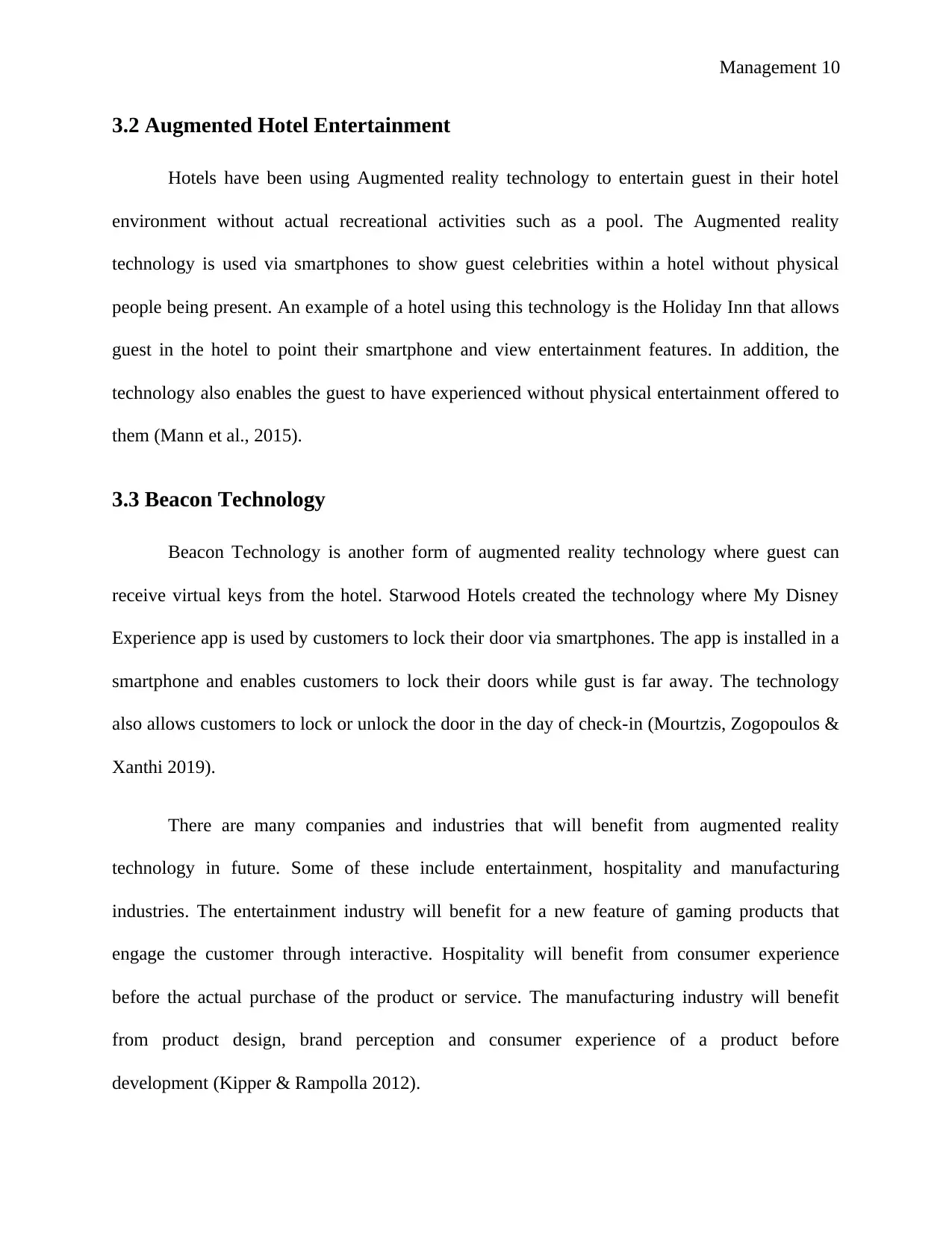
Management 10
3.2 Augmented Hotel Entertainment
Hotels have been using Augmented reality technology to entertain guest in their hotel
environment without actual recreational activities such as a pool. The Augmented reality
technology is used via smartphones to show guest celebrities within a hotel without physical
people being present. An example of a hotel using this technology is the Holiday Inn that allows
guest in the hotel to point their smartphone and view entertainment features. In addition, the
technology also enables the guest to have experienced without physical entertainment offered to
them (Mann et al., 2015).
3.3 Beacon Technology
Beacon Technology is another form of augmented reality technology where guest can
receive virtual keys from the hotel. Starwood Hotels created the technology where My Disney
Experience app is used by customers to lock their door via smartphones. The app is installed in a
smartphone and enables customers to lock their doors while gust is far away. The technology
also allows customers to lock or unlock the door in the day of check-in (Mourtzis, Zogopoulos &
Xanthi 2019).
There are many companies and industries that will benefit from augmented reality
technology in future. Some of these include entertainment, hospitality and manufacturing
industries. The entertainment industry will benefit for a new feature of gaming products that
engage the customer through interactive. Hospitality will benefit from consumer experience
before the actual purchase of the product or service. The manufacturing industry will benefit
from product design, brand perception and consumer experience of a product before
development (Kipper & Rampolla 2012).
3.2 Augmented Hotel Entertainment
Hotels have been using Augmented reality technology to entertain guest in their hotel
environment without actual recreational activities such as a pool. The Augmented reality
technology is used via smartphones to show guest celebrities within a hotel without physical
people being present. An example of a hotel using this technology is the Holiday Inn that allows
guest in the hotel to point their smartphone and view entertainment features. In addition, the
technology also enables the guest to have experienced without physical entertainment offered to
them (Mann et al., 2015).
3.3 Beacon Technology
Beacon Technology is another form of augmented reality technology where guest can
receive virtual keys from the hotel. Starwood Hotels created the technology where My Disney
Experience app is used by customers to lock their door via smartphones. The app is installed in a
smartphone and enables customers to lock their doors while gust is far away. The technology
also allows customers to lock or unlock the door in the day of check-in (Mourtzis, Zogopoulos &
Xanthi 2019).
There are many companies and industries that will benefit from augmented reality
technology in future. Some of these include entertainment, hospitality and manufacturing
industries. The entertainment industry will benefit for a new feature of gaming products that
engage the customer through interactive. Hospitality will benefit from consumer experience
before the actual purchase of the product or service. The manufacturing industry will benefit
from product design, brand perception and consumer experience of a product before
development (Kipper & Rampolla 2012).
Paraphrase This Document
Need a fresh take? Get an instant paraphrase of this document with our AI Paraphraser
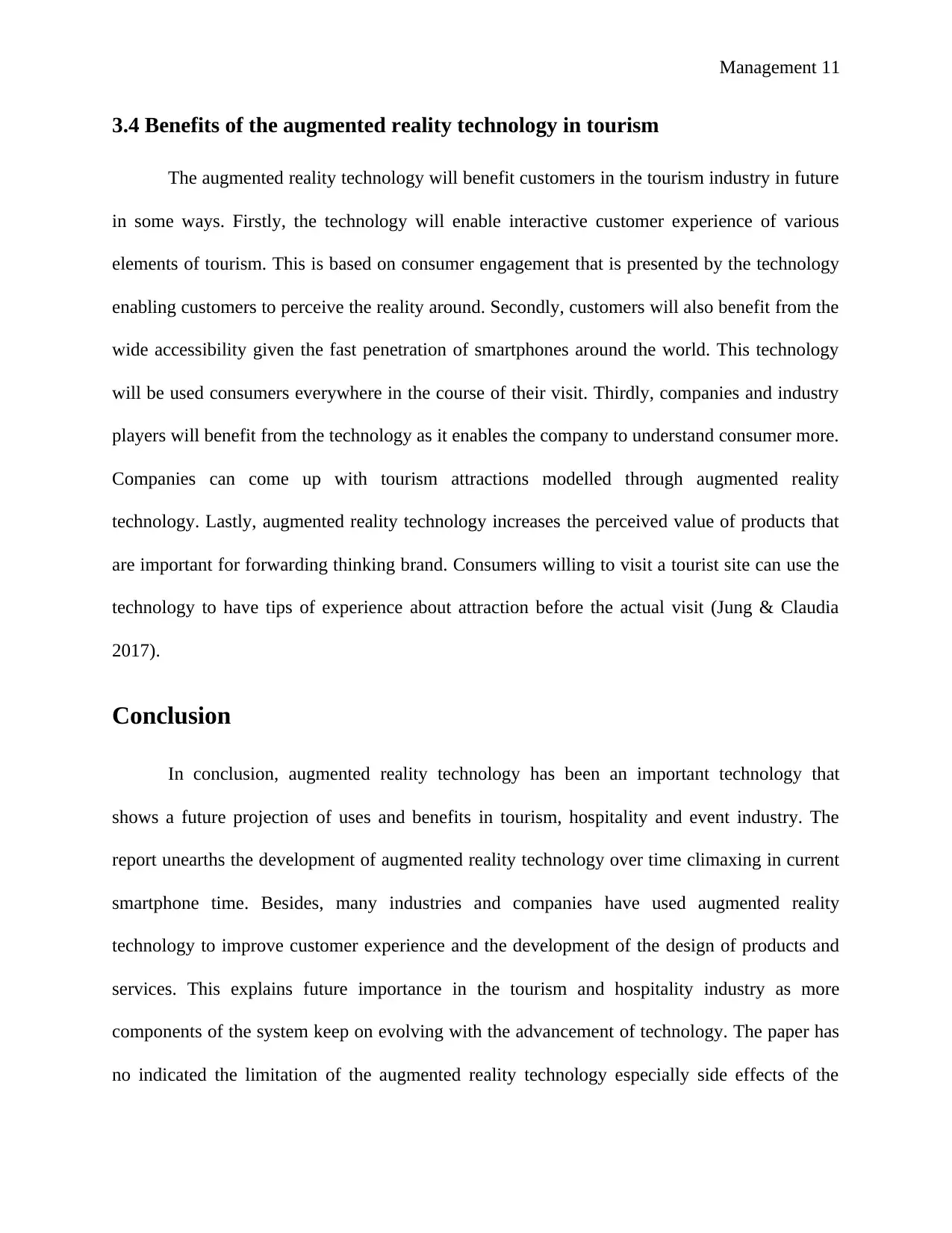
Management 11
3.4 Benefits of the augmented reality technology in tourism
The augmented reality technology will benefit customers in the tourism industry in future
in some ways. Firstly, the technology will enable interactive customer experience of various
elements of tourism. This is based on consumer engagement that is presented by the technology
enabling customers to perceive the reality around. Secondly, customers will also benefit from the
wide accessibility given the fast penetration of smartphones around the world. This technology
will be used consumers everywhere in the course of their visit. Thirdly, companies and industry
players will benefit from the technology as it enables the company to understand consumer more.
Companies can come up with tourism attractions modelled through augmented reality
technology. Lastly, augmented reality technology increases the perceived value of products that
are important for forwarding thinking brand. Consumers willing to visit a tourist site can use the
technology to have tips of experience about attraction before the actual visit (Jung & Claudia
2017).
Conclusion
In conclusion, augmented reality technology has been an important technology that
shows a future projection of uses and benefits in tourism, hospitality and event industry. The
report unearths the development of augmented reality technology over time climaxing in current
smartphone time. Besides, many industries and companies have used augmented reality
technology to improve customer experience and the development of the design of products and
services. This explains future importance in the tourism and hospitality industry as more
components of the system keep on evolving with the advancement of technology. The paper has
no indicated the limitation of the augmented reality technology especially side effects of the
3.4 Benefits of the augmented reality technology in tourism
The augmented reality technology will benefit customers in the tourism industry in future
in some ways. Firstly, the technology will enable interactive customer experience of various
elements of tourism. This is based on consumer engagement that is presented by the technology
enabling customers to perceive the reality around. Secondly, customers will also benefit from the
wide accessibility given the fast penetration of smartphones around the world. This technology
will be used consumers everywhere in the course of their visit. Thirdly, companies and industry
players will benefit from the technology as it enables the company to understand consumer more.
Companies can come up with tourism attractions modelled through augmented reality
technology. Lastly, augmented reality technology increases the perceived value of products that
are important for forwarding thinking brand. Consumers willing to visit a tourist site can use the
technology to have tips of experience about attraction before the actual visit (Jung & Claudia
2017).
Conclusion
In conclusion, augmented reality technology has been an important technology that
shows a future projection of uses and benefits in tourism, hospitality and event industry. The
report unearths the development of augmented reality technology over time climaxing in current
smartphone time. Besides, many industries and companies have used augmented reality
technology to improve customer experience and the development of the design of products and
services. This explains future importance in the tourism and hospitality industry as more
components of the system keep on evolving with the advancement of technology. The paper has
no indicated the limitation of the augmented reality technology especially side effects of the
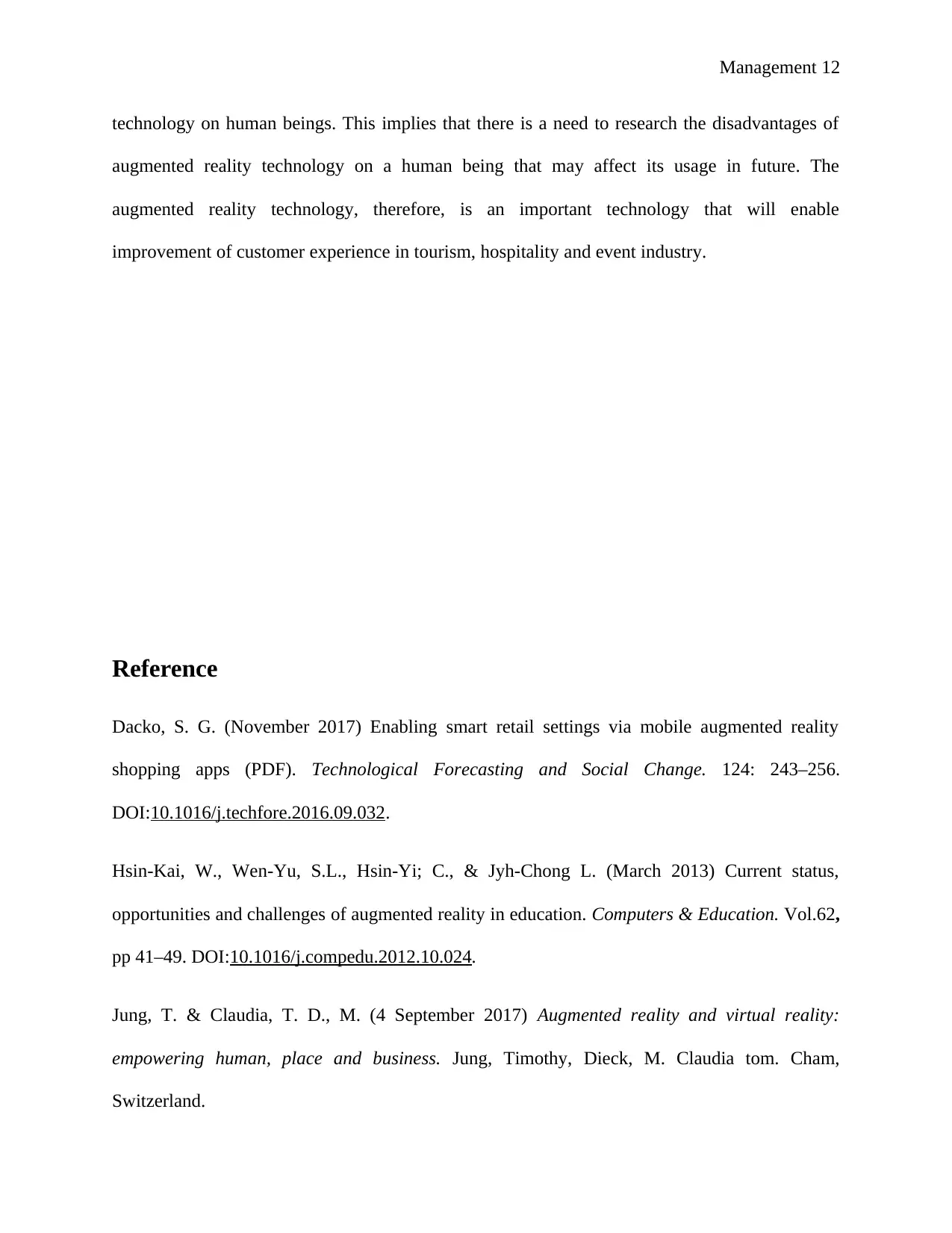
Management 12
technology on human beings. This implies that there is a need to research the disadvantages of
augmented reality technology on a human being that may affect its usage in future. The
augmented reality technology, therefore, is an important technology that will enable
improvement of customer experience in tourism, hospitality and event industry.
Reference
Dacko, S. G. (November 2017) Enabling smart retail settings via mobile augmented reality
shopping apps (PDF). Technological Forecasting and Social Change. 124: 243–256.
DOI:10.1016/j.techfore.2016.09.032.
Hsin-Kai, W., Wen-Yu, S.L., Hsin-Yi; C., & Jyh-Chong L. (March 2013) Current status,
opportunities and challenges of augmented reality in education. Computers & Education. Vol.62,
pp 41–49. DOI:10.1016/j.compedu.2012.10.024.
Jung, T. & Claudia, T. D., M. (4 September 2017) Augmented reality and virtual reality:
empowering human, place and business. Jung, Timothy, Dieck, M. Claudia tom. Cham,
Switzerland.
technology on human beings. This implies that there is a need to research the disadvantages of
augmented reality technology on a human being that may affect its usage in future. The
augmented reality technology, therefore, is an important technology that will enable
improvement of customer experience in tourism, hospitality and event industry.
Reference
Dacko, S. G. (November 2017) Enabling smart retail settings via mobile augmented reality
shopping apps (PDF). Technological Forecasting and Social Change. 124: 243–256.
DOI:10.1016/j.techfore.2016.09.032.
Hsin-Kai, W., Wen-Yu, S.L., Hsin-Yi; C., & Jyh-Chong L. (March 2013) Current status,
opportunities and challenges of augmented reality in education. Computers & Education. Vol.62,
pp 41–49. DOI:10.1016/j.compedu.2012.10.024.
Jung, T. & Claudia, T. D., M. (4 September 2017) Augmented reality and virtual reality:
empowering human, place and business. Jung, Timothy, Dieck, M. Claudia tom. Cham,
Switzerland.
⊘ This is a preview!⊘
Do you want full access?
Subscribe today to unlock all pages.

Trusted by 1+ million students worldwide
1 out of 14
Related Documents
Your All-in-One AI-Powered Toolkit for Academic Success.
+13062052269
info@desklib.com
Available 24*7 on WhatsApp / Email
![[object Object]](/_next/static/media/star-bottom.7253800d.svg)
Unlock your academic potential
Copyright © 2020–2025 A2Z Services. All Rights Reserved. Developed and managed by ZUCOL.





